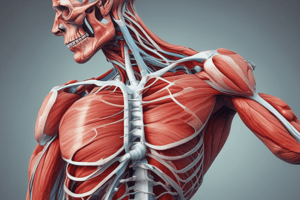Podcast
Questions and Answers
What type of muscles are skeletal muscles?
What type of muscles are skeletal muscles?
- Cardiac muscles
- Voluntary muscles (correct)
- Smooth muscles
- Involuntary muscles
What is the main function of skeletal muscles?
What is the main function of skeletal muscles?
- To aid in digestion
- To regulate body temperature
- To move the body's skeleton and maintain posture and balance (correct)
- To pump blood throughout the body
What is the basic structural unit of a muscle?
What is the basic structural unit of a muscle?
- Myofibril
- Muscle fiber (correct)
- Sarcoplasmic reticulum
- Muscle belly
What type of tissue attaches muscles to bones?
What type of tissue attaches muscles to bones?
What is the point where a muscle attaches to a bone, usually a movable point?
What is the point where a muscle attaches to a bone, usually a movable point?
What is the main part of the muscle where contraction occurs?
What is the main part of the muscle where contraction occurs?
What is the primary purpose of slow-twitch muscles?
What is the primary purpose of slow-twitch muscles?
What is the term for a muscle contraction in which the muscle lengthens while generating force?
What is the term for a muscle contraction in which the muscle lengthens while generating force?
What type of muscle fiber is characterized by a high concentration of myoglobin?
What type of muscle fiber is characterized by a high concentration of myoglobin?
What is the primary function of muscle fibers in skeletal muscles?
What is the primary function of muscle fibers in skeletal muscles?
What is the term for a muscle contraction in which the muscle does not change length, but generates force?
What is the term for a muscle contraction in which the muscle does not change length, but generates force?
What is the purpose of tendons in skeletal muscles?
What is the purpose of tendons in skeletal muscles?
Flashcards are hidden until you start studying
Study Notes
Skeletal Muscles
- Also known as striated muscles
- Voluntary muscles, meaning they can be controlled consciously
- Attached to bones and help move the body's skeleton
- Responsible for movement, posture, and balance
- Examples:
- Biceps and triceps in the arm
- Quadriceps and hamstrings in the leg
- Pectoralis major in the chest
Muscle Anatomy
- Muscle Fiber: The basic structural unit of a muscle
- Composed of:
- Myofibrils (containing actin and myosin filaments)
- Sarcoplasm (cytoplasm of the muscle fiber)
- Sarcoplasmic reticulum (smooth endoplasmic reticulum)
- Mitochondria (for energy production)
- Composed of:
- Muscle Belly: The main part of the muscle, where contraction occurs
- Tendons: Connective tissue that attaches muscles to bones
- Aponeurosis: A type of tendon that is flat and sheet-like, often found in muscles of the back and abdomen
- Muscle Origins: The point where a muscle attaches to a bone, usually a fixed point
- Muscle Insertions: The point where a muscle attaches to a bone, usually a movable point
Skeletal Muscles
- Also known as striated muscles, they are voluntary muscles that can be controlled consciously
- Attached to bones, they help move the body's skeleton and are responsible for movement, posture, and balance
- Found in the arm, leg, and chest, examples include biceps and triceps, quadriceps and hamstrings, and pectoralis major
Muscle Anatomy
- A muscle fiber is the basic structural unit of a muscle, composed of myofibrils, sarcoplasm, sarcoplasmic reticulum, and mitochondria
- Myofibrils contain actin and myosin filaments, which are essential for muscle contraction
- Sarcoplasm is the cytoplasm of the muscle fiber, while sarcoplasmic reticulum is a type of smooth endoplasmic reticulum
- Mitochondria are responsible for energy production in the muscle fiber
- The muscle belly is the main part of the muscle where contraction occurs
- Tendons are connective tissue that attaches muscles to bones, allowing for movement
- Aponeurosis is a type of tendon that is flat and sheet-like, often found in muscles of the back and abdomen
- Muscle origins are the points where a muscle attaches to a bone, usually a fixed point
- Muscle insertions are the points where a muscle attaches to a bone, usually a movable point
Skeletal Muscles
- Also known as striated muscles, attached to bones to facilitate body movement
- Voluntary muscles, controlled consciously
Muscle Composition
- Muscle tissue consists of muscle fibers, connective tissue, and nerve endings
- Muscle fibers contain myofibrils, which are contractile units
- Myofibrils contain myosin and actin filaments that slide past each other during contraction
Muscle Types
- Slow-twitch (red) muscles: for endurance, slow contraction, and high oxygen supply
- Fast-twitch (white) muscles: for speed and power, rapid contraction, and low oxygen supply
Muscle Functions
- Movement: muscle contraction and relaxation to move bones and joints
- Stabilization: maintaining posture and joint stability
- Support: maintaining muscle tone to support body position
Muscle Contraction Types
- Concentric contraction: muscle shortens during contraction (e.g., bicep curl)
- Eccentric contraction: muscle lengthens during contraction (e.g., lowering a weight)
- Isometric contraction: muscle contracts without moving the joint (e.g., wall sit)
Studying That Suits You
Use AI to generate personalized quizzes and flashcards to suit your learning preferences.



